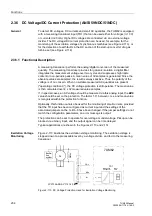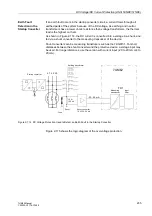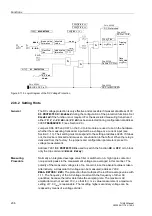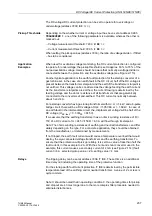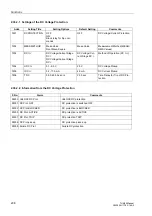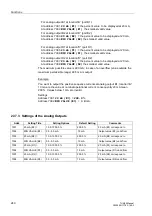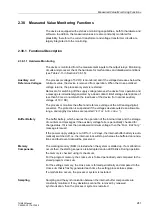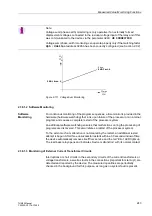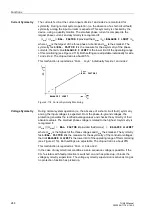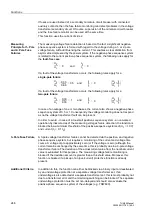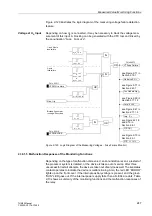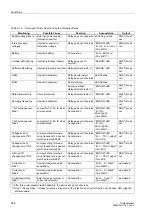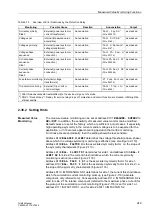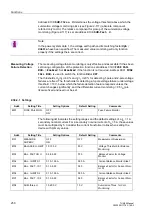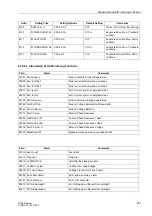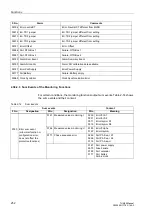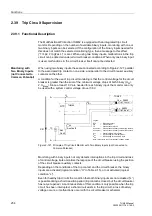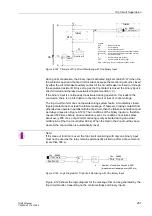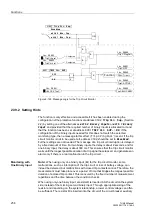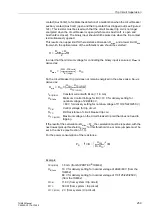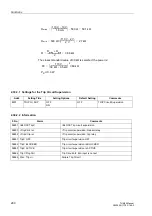
Functions
246
7UM62 Manual
C53000-G1176-C149-3
If fuses are used instead of a secondary miniature circuit breaker with connected
auxiliary contacts, then the fuse failure monitoring can detect problems in the voltage
transformer secondary circuit. Of course, supervision of the miniature circuit breaker
and the fuse failure monitor can be used at the same time.
This function uses the current of side 2.
Measuring
Principle for 1–Pole
and 2–Pole Fuse
Failures
The measuring voltage failure detection is based on the fact a significant negative-
phase sequence system is formed with regard to the voltage during a 1- or 2-pole
voltage failure, without influencing the current. This enables a clear distinction from
asymmetries impressed by the power system. If the negative-phase sequence system
is related to the current positive-phase sequence system, the following rules apply for
the fault-free case:
If a fault of the voltage transformers occurs, the following rules apply for a
single-pole failure:
If a fault of the voltage transformers occurs, the following rules apply for a
two-pole failure:
In case of an outage of one or two phases, the current also shows a negative-phase
sequence system of 0.5 or 1. Consequently, the voltage monitoring does not respond
as no the voltage transformer fault can be present.
In order to avoid - in case of a too small positive-sequence system - an unwanted
operation by inaccuracies of the measuring voltages failure detection, the function is
blocked below a minimum threshold of the positive-sequence systems of (U
1
< 10 V)
and current (I
1
< 0.1 I
N
).
3–Pole Fuse Failure
A 3-pole voltage transformer failure cannot be detected via the positive- and negative
phase sequence system, but requires a monitoring of the current and voltage time
course. A voltage dip to approximately zero (or if the voltage is zero) although the
current remains unchanged by the same time, this is probably due to a 3-pole voltage
transformer failure. The deviation of the actual current value from the nominal current
value is evaluated for this purpose. The measuring voltage failure monitoring is
blocked if the deviation amount is greater than a threshold value. Moreover, this
function is blocked if a pickup of an (overcurrent) protective function is already
present.
Additional Criteria
In addition to this, the function can either be blocked via a binary input or deactivated
by an undervoltage protection at a separate voltage transformer set. If an
undervoltage is also detected at a separate transformer set, this is most probably not
due to a transformer error and the monitoring switching can be blocked. The separate
undervoltage protection must be set non-delayed and should also evaluate the
positive-phase sequence system of the voltages (e.g. 7RW600).
U
2
U
1
-------
0
=
I
2
I
1
----
0
=
and
U
2
U
1
-------
0.33
0.66
-----------
0.5
=
=
and
I
2
I
1
----
0
=
U
2
U
1
-------
I
2
I
1
----
>
è
ø
æ
ö
U
2
U
1
-------
0.33
0.33
-----------
1
=
=
and
I
2
I
1
----
0
=
U
2
U
1
-------
I
2
I
1
----
>
è
ø
æ
ö



